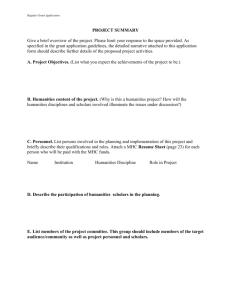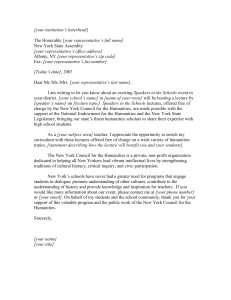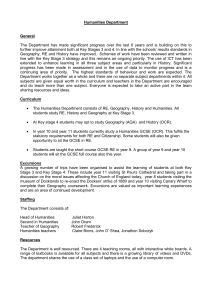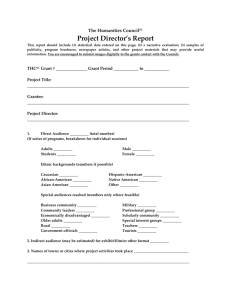GE-10-173. GEOG 270. Introduction to Cultural Geography
advertisement
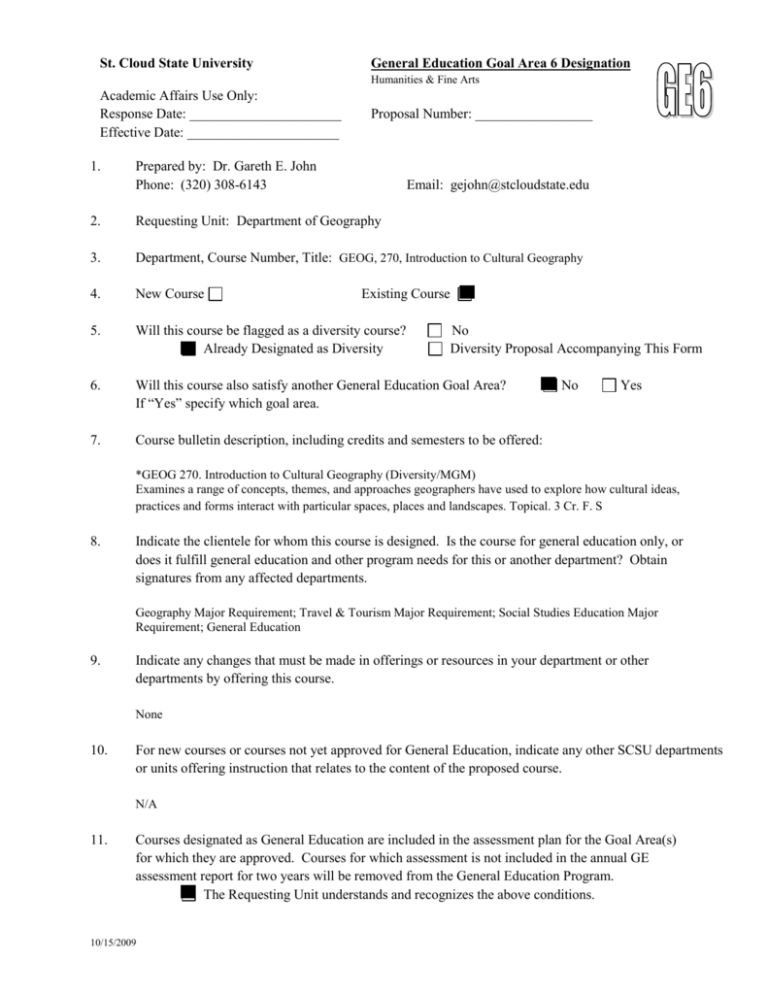
St. Cloud State University General Education Goal Area 6 Designation Humanities & Fine Arts Academic Affairs Use Only: Response Date: ______________________ Effective Date: ______________________ 1. Proposal Number: _________________ Prepared by: Dr. Gareth E. John Phone: (320) 308-6143 Email: gejohn@stcloudstate.edu 2. Requesting Unit: Department of Geography 3. Department, Course Number, Title: GEOG, 270, Introduction to Cultural Geography 4. New Course 5. Will this course be flagged as a diversity course? Already Designated as Diversity 6. Will this course also satisfy another General Education Goal Area? If “Yes” specify which goal area. 7. Course bulletin description, including credits and semesters to be offered: Existing Course No Diversity Proposal Accompanying This Form No Yes *GEOG 270. Introduction to Cultural Geography (Diversity/MGM) Examines a range of concepts, themes, and approaches geographers have used to explore how cultural ideas, practices and forms interact with particular spaces, places and landscapes. Topical. 3 Cr. F. S 8. Indicate the clientele for whom this course is designed. Is the course for general education only, or does it fulfill general education and other program needs for this or another department? Obtain signatures from any affected departments. Geography Major Requirement; Travel & Tourism Major Requirement; Social Studies Education Major Requirement; General Education 9. Indicate any changes that must be made in offerings or resources in your department or other departments by offering this course. None 10. For new courses or courses not yet approved for General Education, indicate any other SCSU departments or units offering instruction that relates to the content of the proposed course. N/A 11. Courses designated as General Education are included in the assessment plan for the Goal Area(s) for which they are approved. Courses for which assessment is not included in the annual GE assessment report for two years will be removed from the General Education Program. The Requesting Unit understands and recognizes the above conditions. 10/15/2009 12. Provide a concise explanation of how the following goal is a “significant focus” of the proposed course. Goal Area 6: Humanities & Fine Arts Expand appreciation and critical understanding of changing modes of human expression and systems of thought in the arts and humanities, and develop abilities in the creation and performance of meaning. GEOG 270 Introduction to Cultural Geography interfaces with the rich tradition of humanistic paradigm of European and American disciplinary geography that has of late come to influence much of the discipline through what has been termed ‘the cultural turn’. This course draws upon numerous works, genres and theories in the arts and humanities to understand the connections between culture (as a dynamic set of ideas, objects and practices) and geography (place, space, region, landscape and environment). Students are taught to critically interrogate the meaning of different cultural ideas, contexts and productions in relation to varied geographical settings and to view cultural life, from shopping to worshipping, as a complex set of intertwining, everyday and site-specific rituals. 13. In order for a course to be designated as fulfilling Goal Area 6, it must address at least 5 of the 7 student learning outcomes (SLOs) below. Check the SLOs below that are focused on in the proposed general education course. 1. Demonstrate awareness of the scope and variety of works in the arts and humanities. 2. Describe and appreciate works in the arts and humanities as expressions of individual and collective values within an intellectual, cultural, historical and social context. 3. Interpret and respond critically to works from various cultures in the arts and humanities. 4. Explore intellectually the ideas expressed in works in the arts and humanities. 5. Engage in creative processes or interpretive performance. 6. Articulate an informed personal response to works in the arts and humanities. 7. Analyze the diverse means of communication in the arts and humanities. 14. Discuss how each Student Learning Outcome checked above is achieved in this course. (Note: Although descriptions of typical assignments or types of assignments may be part of this discussion, it is not appropriate to submit copies of actual assignments.) 2. By interrogating the formation of individual and collective meaning in various works of art such as landscape painting, portraiture, prose, poetry and music as it relates to place- and space-specific and -inspired cultural, historical, social and intellectual contexts: e.g. the meaning of the border as a cultural-geographical cultural context in the work of Frida Kahlo; themes of home and community in the personally inspired and culturally inspiring literature and aural performances of Garrison Keillor; paintings of John Constable, Thomas Gainsborough, Thomas Moran; Albert Bierstadt, Vincent Van Gogh and many others as evocations of national symbolism and identity both then and now; film, painting and literature (e.g. film noir, realism, and postmodernism) as depictions of evolving social change in increasingly ‘placeless’ urban settings; and popular and country music as markers of regional identity to name but a few. Students are evaluated on these themes in quizzes, through written assignments and on exams. 3. A series of cultural productions, including the abovementioned, are subjected to critical commentary and interrogation according to intranational themes in Britain and the United States of the exclusionary and colonial bases of nationhood, race and ethnicity (e.g. examination of the Chicano Mural Movement); and gender, class and sexuality (via discursive analyses of the films like Shirley Valentine, Billy Elliot and The Full Monty. Much of this is developed through class discussion which makes up 10% of the graded component of the course. 10/15/2009 4. A constellation of ideas expressed in various art forms are explored intellectually in terms of the relationship between the genres of cultural productions and their broader informing intellectual trends and social contexts. These include intellectual movements like the Enlightenment and Humanism, Romanticism and Aestheticism, Modernity and Modernism, Cubism and Realism, and Postmodernity and Postmodernism; humanistic methods and approaches such as iconography (Panofsky) and iconology (WJT Mitchell); and humanistic geography and its take on the arts and humanities as important sources of geographical knowledge and experience. At the same time national schools of thought in the arts and humanities are considered: from the Hudson River School of American landscapists to the Mexican Muralists of the New Deal Era; from the ideas of in anthropology and political theory in pre-Nazi Germany to the radicalism of the Birmingham School of Cultural Studies in the 1970s and 1980s; from Heideggerian philosophy (on habitat and home in “Building, Dwelling, Thinking”) to the Frankfurt School of Critical Social Theory in the 1930s and 40s. 6. Through graded online and general in-class discussion and written sections in course examinations students are encouraged to give personal and informed responses to works of art and in the humanities, from regional literature to nationalist landscape paintings to post-revolutionary Iranian political art. 7. The course develops the various modes that media in the arts and humanities is communicated and is greeted by the senses. Drawing on work on iconology by Erwin Panofsky and WJT Mitchell students are introduced to the intricate interplay between texts and images, sight and sound , the physical and ethereal, that creates either analogue or digital forms of media in painting, literature, sculpture, television, film, advertising, and radio. 15. List or attach the Course Outline (adequately described and including percentage of time to be allocated to each topic). Curriculum Committees may request additional information. Topics larger than 20% need to be broken down further. Indicate in your course outline where the Student Learning Outcomes checked above are being met. Themes Exploring Cultural geography: Concepts and Ideas Mapping Culture and Cultural Change Geographies of Popular Culture Geographies of Race and Ethnicity Place Politics of Gender, Sexuality and Class Cultures of Production and Consumption Concepts and Meaning of Home as Scalar Globalizing and Transnational Cultures and the Future 10/15/2009 Time 20% 10% 10% 10% 20% 10% 10% 10% SLOs 2, 3, 4, 6, 7 4 2, 3, 4, 6, 7 2, 7 2, 4, 7 2, 6, 7 2, 6, 7 2, 3, 6, 7





